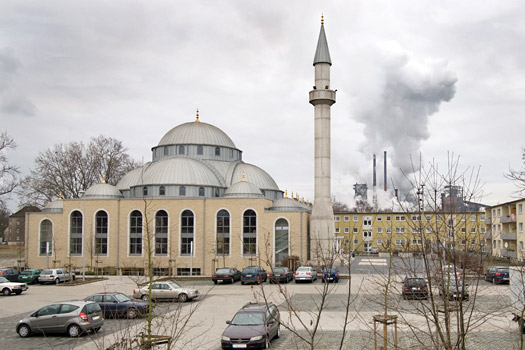
Vielfalt der Religionen nach 1945
Der Islam ist heute die drittstärkste Religion in der Bundesrepublik. Ein Drittel der muslimischen Bevölkerung lebt in Nordrhein-Westfalen und dort vor allem in der Ruhrregion. Ab etwa 1966 wurden zunächst in vorhandenen Gebäuden Moscheen eingerichtet, später entstanden islamische Gotteshäuser auch als Neubauten. Die neue Moschee in Duisburg-Marxloh wurde im Oktober 2008 eingeweiht.
© Foto Dietrich Hackenberg
Glaube zurück zur Auswahl
Diversity of Religions after 1945
The period after 1945 saw a further increase in the influx of different nations and religions into the Ruhr Region. These new arrivals continually bring new impetuses into the region; partly as communities living next to each other, but more and more as communities living with each other; thus, they actively participate in the shaping of culture in the Ruhr region.
After the end of the Second World War, the two Christian churches quickly established themselves again. Due to the large number of displaced people, parishes and churches were built and formed particularly in the Ruhr Region during the post-war period. The integration of the so-called Ruhr Poles into the Catholic Church was successfully achieved, yet at this point many catholics, particularly from Upper Silesia arrived in the Rhine region and brought new customs from their home regions.
The approximately two million Poles transported to the Ruhr as prisoners of war and forced labourers during the Second World War were under the pastoral care of Polish clergymen; since 1970 Dortmund has had a Polish mission.
Despite large-scale immigration directly after the war, at the time of the economic miracle significant labour shortage developed in the mining and steel-producing industries.
Hence, between 1955 and 1968 bilateral agreements were made for acquiring workers with Italy, Spain, Greece, Turkey, Portugal, Tunisia, Morocco, and Yugoslavia. At first the workers often lived in settlements of immigrants from the eastern provinces, e.g. in the Pluto IV Mining Colony in Wanne-Eickel and also in the former accommodations of World War II forced labourers, such as the Gewerkenstraße in Bochum-Gerthe in the camp of Lothringen III. In terms of religion, the Catholic Church was responsible for Italian and Spanish catholics. Dortmund had Spanish missions, e.g. in the St. Anna Church (until 1993).
From Greece, predominantly orthodox christians came, who to this day are divided into nine Greek Parish Associations in the Ruhr Region. Dortmund-Wambel has a Greek grammar school and a lyceum. Apart from Herten, there are no individually built Greek-Orthodox Church buildings. The Greek parishes mostly took over empty churches of other denominations, and used these according to their own needs.
Serb orthodox christians from the former Yugoslavia formed two church parishes in the region. As with the Greek orthodox community, the parishes organize many cultural activities.
The Russian orthodox communities in the Ruhr Region were, except for a short period after the Second World War, very small, and, by the beginning of the 1990s, over-aged.
The influx of orthodox Christians from the countries of the former Soviet Union brought new life to these communities along with their strong connections to their homeland. Sunday schools and social establishments were founded as a result.
Workforce from Turkey, Morocco, Tunisia and Yugoslavia were primarily Muslim. Islam today is the third strongest religion in the Federal Republic. One third of the Muslim population lives in North Rhine-Westphalia, and there, first and foremost, in the Ruhr Region. The need to gather and pray led already in 1966 to the founding of the first mosque and a Turkish Labour Association in Dortmund.
Besides migration of labour, there is also international migration and refugees who immigrate on political grounds, and would like to practice their religion in the Ruhr Region. One example of this is the Hindu temple in Hamm, founded by a Tamil priest who, as a young man, fled the civil war in his homeland Sri Lanka in 1985.
Denkmale zum Impuls
Haltern - Wallfahrtsstätte Annaberg
Im Mai 1566 brach auf dem Annaberg bei Haltern eine Quelle auf. In ihr wusch sich ein Kranker ... weiter
Marl - Fatih-Moschee
1992 ließ der Verein für türkische Arbeitnehmer, mithilfe von Spenden, in Marl ... weiter
Hamm - Hindutempel Sri Kamadchi Ampal
2002 ist im Gewerbegebiet von Hamm-Uentrop der größte tamilisch-hinduistische Tempel ... weiter
Dortmund - St. Anna
Als in den letzten Jahrzehnten des 19. Jahrhunderts massenhaft Arbeiter nach Dortmund kamen, ... weiter
Datteln - Russisch-orthodoxe Kirche Boris und Gleb in Horneburg
Die Beziehungen des Dattelner Ortsteils Horneburg zu Russland sind alt, wenngleich sporadisch. ... weiter
Dortmund - Serbisch-orthodoxe Hl.-Apostel-und-Evangelist-Lukas-Kirche
In den 1960er Jahren kamen durch Anwerbeverträge zahlreiche Gastarbeiter nach Deutschland, ... weiter
Duisburg - Neue Synagoge
Die Jüdische Gemeinde von Duisburg, Mülheim und Oberhausen wuchs in den 1970 und ... weiter
Duisburg - Griechisch-orthodoxe Kirche der Hll. Apostel Petrus und Paulus
In den 1960er Jahren kamen zahlreiche griechische Arbeiterinnen und Arbeiter, vor allem aus ... weiter
